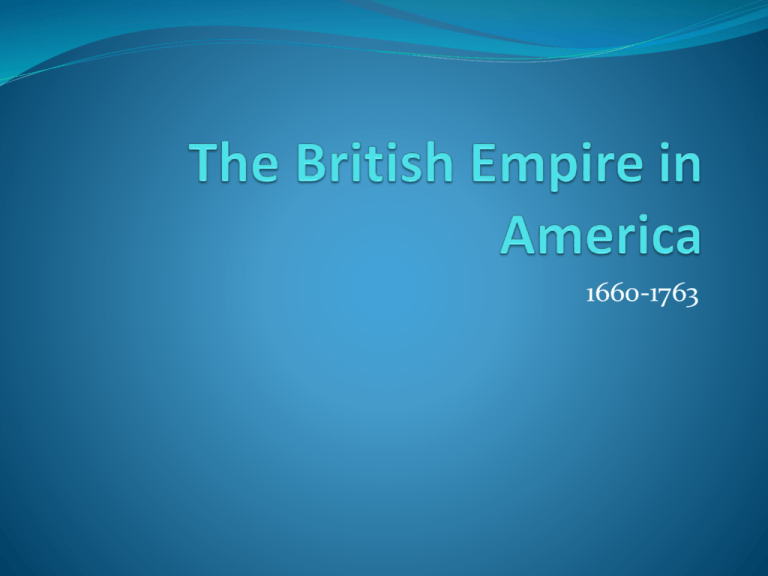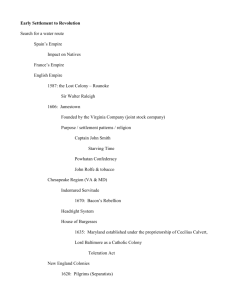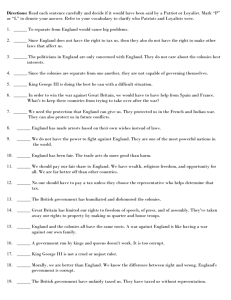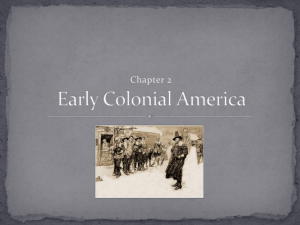The British Empire in America
advertisement

1660-1763 By 1670, there were approximately 55 000 whites living in New England The ‘Indian’ population, estimated to have been 120 000 in 1570, had shrunk to 70 000 in 1620, and barely 16 000 by 1670. • In 1675-6, Metacomet, leader of the Wampanoag, united with the Narragansett and Nipmuck to attack the white colonies of New England. • 20% of English towns in Massachusetts and Rhode Island were burned, and 5% of the adult whites were killed. • The attacks ended with Metacomet’s death. • The natives paid a heavy price – up to 25% of the New England natives were killed from famine and disease as well as the battles themselves. • Many of the survivors were sold into slavery, including Metacom’s wife and 9year-old son. • New England natives were forced to accept their dependent status and lived on the margins of white society • They had lost land and people, and would see the integrity of their traditional cultures dwindle. Relationships between the settlers and natives were built on trade. The natives would give furs for iron utensils and cloth blankets. Within a few generations, the erosion of traditional artisanal skills created greater dependence on the colonists. Culture was also lost due to the fur trade. Warriors of the Micmac in Nova Scotia claimed that they no longer knew “whether the beavers were among our friends or our enemies.” (see pages 75-76 and 97 in the textbook) The Road To Revolution Important concepts to understand: How Parliament sought to tighten political control over the colonies Why colonists resorted to political protest against British policies For the most part, the British attitude toward the colonies was that they existed to provide England with goods from the New World. For a time, salutary neglect was policy – this was meant to limit the number of regulations on the colonies in order to allow them to flourish. As the colonies grew, so too did their desire for independence and self-sustenance To avoid dealing with the relatively lenient laws that WERE in place, many merchants would just smuggle goods. Eventually, Parliament decides that it must get involved and begin enforcing its laws. In 1651, Parliament passed the Navigation Act, whereby all goods shipped between England and the colonies had to be carried in ships build either in England or the colonies. This would limit trade with other countries In 1660, Parliament lists “enumerated articles” such as tobacco, cotton, sugar, and indigo, which could be shipped only to England. This lowered prices for plantation owners, as it limited demand despite everincreasing supply (and led to the rise of huge plantations, as they were the only ones that would be truly profitable). It also limited the growth of the colonial economy, because they couldn’t sell their product to the Dutch, who offered the most money. Other Trade Acts: • 1699 – The Woolen Act – Forbids the export of wool from the American colonies • 1732 – The Hat Act – forbids the export of hats from the American colonies • 1733 – The Molasses Act – • Puts a heavy tax on the import of sugar and molasses. Helps the British West Indes plantation owners. 1750 – The Iron Act – restricted the manufacture of iron in America. This policy of mercantilism (or the belief that strict control of foreign trade is necessary for a country’s survival) slowed the development of the colonies. The Americans were crafty, however, and were prone to bribing the deputies whose role was to enforce the laws and collect taxes in their name. The Revenue Act of 1762, however, put an end to deputies standing in place of those whose job was to enforce the laws and collection of taxes and tariffs. In 1763 England sent 10 000 troops to North America To prevent the rebellion of 60 000 French in Quebec who had just lost the French-Indian war, and who had had to cede North America to the British. To protect the colonies from the Spanish, who wanted Florida back To protect the Proclamation line, which in 1763 was established as a border between the natives and landhungry whites The British had amassed significant debt in fighting the French for control of North America. In 1754, their national debt was 75 million pounds. By 1763, that number had increased to 133 million.






